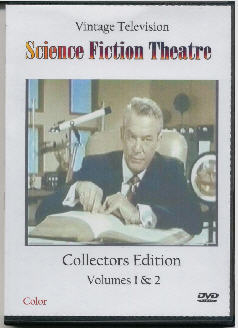A 1950s sci-fi show, mending broken hearts- and WiMAX


Yes, but what about WiMAX? Yes, you read that right.
Today is a day when we think about hearts. With that theme in mind, let me take you back to a mostly forgotten, but great tv series from the mid-1950s entitled "Science Fiction Theatre."
The opening 30-minute episode from the 1956 season was titled Signals From The Heart. Hosted by Truman Bradley, this episode opened with an overweight, out-of-shape 50-something police officer named Patrolman Tom Horton chasing a fleet-footed burglar.
The burglar scales a fence, and Ptl. Horton tries to follow. He struggles for breath and collapses with a heart attack.
In the hospital, Horton- who as I recall from a repeat airing in the 1960s had to retire because of his heart attack - is retrofitted with a device that will constantly monitor his heart rate. At the first sign of irregularity, the device would radio that information to a central monitoring unit at the hospital where he is treated. The point was that with this information, Horton's physicians could be proactive and send help rather than wait for an emergency call that could come too late. I seem to recall a later scene when the device helped save his life.
What was depicted 50 years ago is what my colleague Dana Blankenhorn has been sounding the drums about for years now- an "always-on," health monitoring application that elevates emergency response and care from the reactive to the proactive.
Last Friday, the Reuters news service ran an article entitled Wireless to organize- and maybe save- lives.
In his excellent piece, writer Sinead Carew writes of "wireless sensors for potentially life-saving applications.
"Professor John Guttag from the Massachusetts Institute of Technology is studying how wirelessly connected medical devices, such as heart-monitor sensors, could automatically send warnings of a problem to the patient's cell phone and then on to a relative or a doctor," Carew writes.
"If your elderly parent is having trouble breathing, you can't rely on them to do something (like send a text message or make a call)," Carew quotes Guttag as saying. "It would have to happen automatically."
Well, I suppose this could be done via cell, but I see limitations. In the case of Patrolman Horton, maybe the cell phone falls out during a chase. And what about at night? What about dead cell batteries? Or if the patient is injured and is separated from h/her cell? (In the height of irony, actor Gene Roth- who played Patrolman Horton- was killed by a car while crossing a Los Angeles street in 1976).
That's why I prefer the "Science Fiction Theatre" model of heart-monitoring chips that could be installed within the bodies of at-risk patients. When something goes wrong, the chip could send a packetized alert to a tower that would authenticate that patient and then quickly - emphasis on quickly - use WiMAX route that info across town to the patient's health care facility.
On this day when we think about other matters of the heart, let us envision the future - and how a vision from a long-forgotten (though not by me) science-fiction series can enable us to save lives.